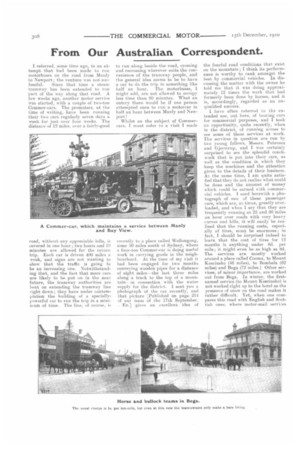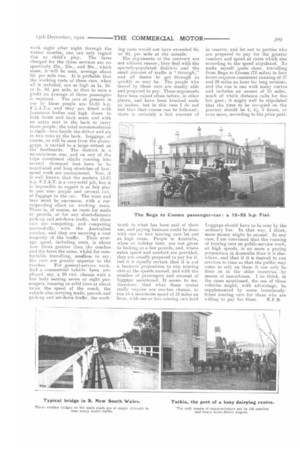From Our Australian Correspondent.
Page 14

Page 15

If you've noticed an error in this article please click here to report it so we can fix it.
I referred, some time ago, to an attempt that had been made to run motorbuses on the road from Manly to Newport; the venture was not sue fessful. Since that time a steam tramway has been extended to run part of the way along that road. A few weeks ago, another motor service wa-s started, with a couple of two-ton Commer-cars. The promoters, at the time of writing, have been running their two cars regularly seven days a week for just over four weeks. The distance of 12 miles. over a fairly-good
road, without any appreciable hills, is covered in one hour ; two hours and 10 minutes are allowed for the return trip. Each ear is driven 400 miles a week, and signs are not wanting to show that the traffic is going to be an increasing one. Notwithstanding that, and the fact that more ears are likely to be put on in the near future, the tramway authorities are bent on extending the tramway line right down; they have under contemplation the building of a speciallypowerful car to run the trip in a minimum of time. The line, of course, is
to run along beside the road, crossing and recrossing wherever suits the convenience of the tramway people, and the general idea seems to be to have a car to do the trip in something like half an hour. The motorbuses, I might add, are not allowed to occupy less time than 60 minutes. What an outcry there would be if one person attempted once to run a motorcar in half an hour between Manly and Newport.!
Whilst on the subject of Commercars. I must refer to a visit T made
recently to a place called Wollongong, some 50 miles south of Sydney, where a four-ton Commer-ear is doing useful work in carrying goods in the neighbourhood. At the time of my visit it had been engaged for two months conveying wooden pipes for a distance of eight miles—the last three miles along a track to the top of a mountain—in connection with the water supply for the district. I sent you a photograph of the car recently, and that picture L-Published on page 214 of our issue of the 17th September.
En.] gives an excellent idea of the fearful road conditions that exist on the mountain ; I think its performance is worthy to rank amongst the best by commercial vehicles. In discussing the matter with the owner he told me that it was doing approximately 12 times the work that had formerly been done by horses, and it is, accordingly, regarded as an unqualified success.
I have often referred to the extended use, out here, of touring cars for commercial purposes, and 1 took an opportunity, quite recently, when in the district, of running across to see some of these services at work. The services in question are run by two young fellows, Messrs. Petersen and Gjerstrup, and I was certainly surprised to see the splendid coachwork that is put into their cars, as well as the condition in which they keep the machines and the attention given to the details of their business. At the same time, I am quite satisfied that they do not realize what could be done and the amount of money which could be earned with commercial vehicles. I send herewith a photograph of one of these passenger cars, which are, at times, greatly overloaded, and when I say that they are frequently running at 25 and 30 miles an hour over roads with very heavy curves and hills, it will easily be realized that the running costs, especially of tires, must be enormous ; in fact, I should be surprised indeed to learn that the cost of tires for 12 months is anything under 6d. per mile; it might even be as high as 8d. The services are mostly worked around a place called Cooma, to Mount Kosciusko (46 miles), to Bombala (62 miles) and Bega (72 miles.) Other services, of minor importance, are worked out from Bega. In winter, the firstnamed service (to Mount Kosciusko) is not worked right up to the hotel as the presence of snow on the road makes it rather difficult. Yet, when one compares this road with English and Scottish ones, where motor-mail services
work night after night through the winter months, one can only regard this as child's play. The fares charged for the three services are respectively 25s., 25s., and 30s., which sums, it will be seen, average about Od. per mile run. It is probable that the working costs of these cars, when all is included, are as high as is. 2d. or Is. 3d. per mile, so that to earn a profit an average of three passengers is required. The cars at present in use by these people are 15-25 F.1.A.T.s, and they are fitted with luxurious bodies and high doors to both front and hack seats and with an extra seat in the back to carry three people; the total accommodation is eight—two beside the driver and six in two rows at the back. Luggage, of course, as will be seen from the photograps, is carried to a large extent on the footboards. The district is a mountainous one, and on any of the trips mentioned climbs running into several thousand feet have to be negotiated and long stretches of firstspeed work are encountered. Now, it is well known that the modern 15-25 h.p. is a very-solid job, but it is impossible to regard it as fair play to put nine people and several cwt. of luggage in the car. The wear and tear must be enormous, with a corresponding effect on working costs. There is, of course, no room for mails or parcels, or for any short-distance pick-up and set-down traffic, but these cars are competing, and competing successfully, with the Australian coaches, and they are securing a vast majority of the traffic. Their average ;Teed, including rests, is about four times greater than the coaches and the fares the same, whilst for comfortable travelling, needless to say, the cars are greatly superior to the coaehes. For general-service work, had a commercial vehicle been employed, say, a 20 cwt. chassis with a bus body seating seven or eight passengers, running on solid tires at about twice the speed of the coach, the vehicle also carrying mails, parcels and pick-up and set-down traffic, the work ing costs would not have exceeded 8d. or M. per mile at the outside.
The arguments to the contrary are not without reason ; they deal with the sparsely-populated districts and the small amount of traffic is " through," and all desire to get through as quickly as may be. The people who travel by these cars are mostly able and prepared to pay. These arguments have been raised often before, in other places, and have been brushed aside as useless, but in this case I do not feel that that course can be followed ; there is certainly a fair amount of truth in what has been said of their use, and paying business could be done with one or two touring cars let out at high rates. People in Australia, when on holiday bent, are not given to looking at a few pounds, and, where extra speed and comfort are provided, they are usually prepared to pay for it, but it is equally certain that it is not a business proposition to run touring cars at. the speeds named, and with the number of passengers and amount of luggage mentioned. It seems to me, therefore, that what these routes really require are one-ton chassis, to run at a maximum speed of 18 miles an hour, with one or two touring ears held in reserve, and let out to parties who are prepared to pay for the greater comfort and speed at rates which rise according to the speed stipulated. To make myself quite clear, travelling from Bega to Coma (72 miles) in four hours requires consistent running of 27 and 28 miles an hour for long sections, and the run is one with many curves and includes an ascent of 15 miles, much of which distanee calls for the low gear ; it might well he stipulated that the time to be occupied on the journey should be 4, 4 5 hours, or even more, according to the price paid.
Luggage should have to be sent by the ordinary bus. In that way, I think, more money might be earned. In any case, I am convinced that the running of touring cars on public-service work, at high speeds, is no more a paying proposition in Australia than it is elsewhere, and that if it is desired to run services to time so that the public may come to rely on them it can only be done as in the older countries—by means of motorbuses. I do think, in the cases mentioned, the use of these vehicles might, with advantage, be supplemented by some luxuriouslyfitted touring cars for those who are willing to pay for them. E.F.B.




















